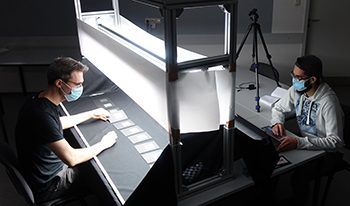
Gloss perception is a complex psychovisual phenomenon, whose mechanisms are not yet fully explained. Instrumentally measured surface reflectance is usually poor predictor of human perception of gloss. The state-of-the-art studies demonstrate that, in addition to surface reflectance, object's shape and illumination geometry also affect the magnitude of gloss perceived by the human visual system (HVS). Recent studies attribute this to image cues – the specific regularities in image statistics that are generated by a combination of these physical properties, and that, in their part, are proposedly used by the HVS for assessing gloss. Another study has recently demonstrated that subsurface scattering of light is an additional factor that can play the role in perceived gloss, but the study provides limited explanation of this phenomenon. In this work, we aimed to shed more light to this observation and explain why translucency impacts perceived gloss, and why this impact varies among shapes. We conducted four psychophysical experiments in order to explore whether image cues typical for opaque objects also explain the variation of perceived gloss in translucent objects and to quantify how these cues are modulated by the subsurface scattering properties. We found that perceived contrast, coverage area, and sharpness of the highlights can be combined to reliably predict perceived gloss. While sharpness is the most significant cue for assessing glossiness of spherical objects, coverage is more important for a complex Lucy shape. Both of these observations propose an explanation why subsurface scattering albedo impacts perceived gloss.

A psychophysical study on two series of printed metallized surfaces, which both consisted of ten samples was performed. Two groups participated in the experiment. These were experts, who regularly judge the appearance of printed samples at their daily work, and amateurs who do not regularly visually judge and compare samples. For the experiments, a special light booth for conducting visual experiments with focus on gloss was designed and a ranking experiment was worked out. It was investigated how observers look at these kind of surfaces when asked to judge their glossiness, lightness, roughness, the sharpness of reflected images, and metallicity. All samples had the same size and nearly no hue but differed in gloss and texture. It was examined how the ratings of the targeted characteristics of appearance correlate with each other, and how they correlate with the gloss measured at the specular angles of 20°, 60°, and 85° and the distinctness-of-image measured with an IQ-S gloss meter. Additionally, observers were inquired for their individual understanding of gloss.

Intensive observation of the world, and the intention of realistically transferring it to the canvas, allowed Dutch Golden Age painters to develop an implicit knowledge of the visual patterns people use to infer different materials, imitating key optical phenomena via shortcuts. To understand the origin of the astonishing realism of Dutch 17th century paintings, we refer to the treatise of Willem Beurs, "The Big World Painted Small", a precious source of technical information about oil painting. One of the questions we aim to answer is: how did they produce such true-to-life depictions? We chose the representation of grapes as case study, due to the simultaneous presence and interaction of different material properties, like glossiness, translucency and bloom. Glossiness and translucency are of primary importance in vision science. Thus, understanding their rendering and perception for the case of grapes, can lay the groundwork for a more general theory of gloss and translucency. We investigated if the material properties proposed by Beurs to paint grapes are actually perceived in paintings, and how they relate to their perceived convincingness. Among these material qualities, we took a closer look at glossiness and tried to predict its perception via image statistics of specular reflections.